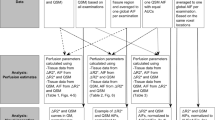Summary
The development of rapid magnetic resonance imaging (MRI) sequences makes it possible to detect the fast kinetics of tissue response after intraveneous administration of paramagnetic contrast media (CM), reflecting the status of tissue microcirculation. In this paper, the basic physical and tracer kinetic principles of dynamic relaxivity and susceptibility contrast MRI techniques are reviewed. The quantitative analysis of the acquired dynamic image data is broken up into an MR specific part, in which the observed signal variations are related to the CM concentration in the tissue, and an MR independent part, in which the computed concentration-time-courses are analyzed by tracer kinetic modeling. The purpose of the applied models is to describe the underlying physiological processes in mathematical terms and thus to enable the estimation of tissue specific parameters from measured dynamic image series. Whereas the capillary permeability can be estimated from dynamic relaxivity contrast enhanced MRI studies, the regional blood volume as well as the regional blood flow can be determined from dynamic susceptibility contrast enhanced image series. However, since there are no intravascular but only diffusible CM available at present, the application of the susceptibility technique is currently restricted to brain tissues with intact blood brain barrier. The practical realization of both dynamic MRI techniques is demonstrated by case studies.
Zusammenfassung
Durch die Entwicklung von schnellen MR-Bildgebungssequenzen ist es möglich geworden, die rasche zeitliche Veränderung des Gewebesignals nach intravenöser Applikation eines paramagnetischen Kontrastmittels (KM), die die Mikrozirkulation im Gewebe widerspiegelt, meßtechnisch zu erfassen. In dieser Arbeit werden die physikalischen und tracerkinetischen Grundlagen der relaxations- und suszeptibilitätsgewichteten dynamischen MR-Tomographie (dMRT) vorgestellt. Die quantitative Analyse der gemessenen dynamischen Bilddaten gliedert sich bei beiden Ansätzen in 2 Schritte: einen MR-spezifischen Teil, in dem die gemessene MR-Signalveränderung mit der lokalen KM-Konzentration im Gewebe verknüpft wird, so daß die akquirierten Signal-Zeit-Verläufe in Konzentrations-Zeit-Verläufe umgerechnet werden können, und einen MR-unabhängigen Teil, in dem die Konzentrations-Zeit-Verläufe mittels geeigneter tracerkinetischer Modelle analysiert werden. Durch die Modellbildung wird physiologisches und histologisches Vorwissen bezüglich der Mikrozirkulation im Gewebe mathematisch formuliert, so daß relevante Gewebeparameter quantitativ aus den dynamischen Bildserien berechnet werden können. So bietet die relaxationsgewichtete dMRT die Möglichkeit, die Permeabilität der Blutgefäße in der terminalen Strombahn zu beurteilen, während mit der suszeptibilitätsgewichteten dMRT das regionale Blutvolumen und der regionale Blutfluß bestimmt werden kann. Da bislang noch keine intravasalen sondern nur diffusible MR-KM für klinische Studien zugelassen sind, ist die Anwendung der suszeptibilitätsgewichteten dMRT derzeit allerdings auf Hirngewebe mit intakter Blut-Hirn-Schranke eingeschränkt. Die praktische Anwendung der beiden dMRT-Techniken wird jeweils an einem klinischen Fallbeispiel erläutert.
Similar content being viewed by others
Author information
Authors and Affiliations
Additional information
Eingegangen am 5. März 1997 Angenommen am 24. April 1997
Rights and permissions
About this article
Cite this article
Brix, G., Schreiber, W., Hoffmann, U. et al. Methods for quantitative assessment of tissue microcirculation using dynamic contrast-enhanced MR imaging. Radiologe 37, 470–480 (1997). https://doi.org/10.1007/s001170050241
Issue Date:
DOI: https://doi.org/10.1007/s001170050241




